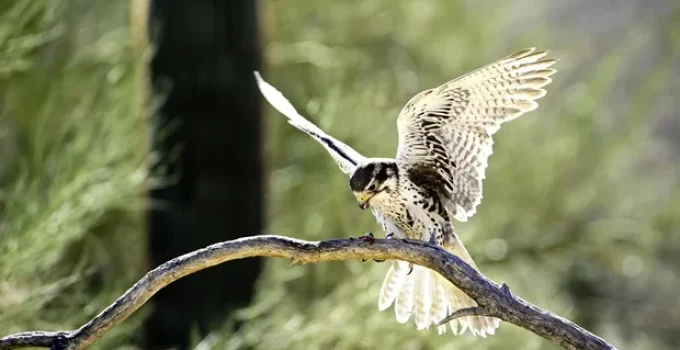How Do Falcons Communicate?
Falcons are not known for singing melodies like songbirds, but they communicate using a mix of vocalizations, body language, and visual displays. From defending territories to bonding with mates, falcons rely on sharp, concise signals to convey meaning in their fast-paced world.
🔍Dive Deeper
- Vocal Communication in Falcons
- Nonverbal Communication: Body Language & Displays
- Falcon Chick Communication
- Courtship and Mating Signals
- Why Communication Matters
- 🎯 Final Thoughts
- 📚 References
Vocal Communication in Falcons
Falcons use short, piercing calls rather than complex songs. Their vocal repertoire is limited but effective, especially in:
- Territory defense
- Alarm warnings
- Mate calling
- Parent-chick interaction
Each species has distinct calls. For example:
| Species | Common Call Type | Description |
|---|---|---|
| Peregrine Falcon | Kak-kak-kak! (alarm) | Rapid series of loud, harsh notes |
| American Kestrel | Klee-klee-klee | A sharp call used during excitement or aggression |
| Merlin | Ki-ki-ki | A higher-pitched warning or nesting area alert |
📌 Fun Fact: Peregrine Falcons can emit alarm calls at over 60 decibels—as loud as a human shout [1].
Nonverbal Communication: Body Language & Displays
Falcons also rely heavily on posture, movement, and wing positions to send nonvocal cues:
- Wing-fluttering: Often seen in fledglings or submissive birds.
- Head-bobbing: Used to assess depth or focus vision, especially before flight or attack.
- Mantling: A defensive gesture where the falcon spreads its wings over food, signaling “back off.”
- Stooping posture: A downward dive with tucked wings, signaling predation or territorial assertion.
Visual displays, especially in open-air or cliff habitats, are crucial for falcons, who must communicate at long distances or from aloft.
Falcon Chick Communication
Young falcons, or eyasses, begin vocalizing within days of hatching. Their communication includes:
- Begging calls: High-pitched and repetitive, used to demand food.
- Distress calls: Sharp chirps when separated from parents or siblings.
- Mimicry of adults: As they grow, chicks adopt adult calls and behaviors.
Parents respond rapidly to chick communication, especially during feeding and fledging. According to a study in The Condor, chicks that vocalize more frequently are often fed more [2].
| 📊 A 2020 observation study noted that kestrel chicks called up to 100 times per hour during feeding periods.
Courtship and Mating Signals
During courtship, falcons engage in an elaborate mix of calls, aerial acrobatics, and physical displays:
- Aerial exchanges: Males pass food to females mid-flight as a form of bonding.
- Bowing: Performed at nest sites; one bird bows its head while calling.
- Calling duets: Mated pairs often vocalize in synchrony, reinforcing pair bonds.
These behaviors are not just romantic—they help pairs coordinate nesting, food delivery, and chick rearing.
| 🧠 Falcons that maintain multi-year partnerships (like Peregrines) refine these signals to near-automatic precision [3].
Why Communication Matters
In falcons, communication supports:
- Territorial integrity: Loud calls deter rivals.
- Nesting success: Parents and chicks coordinate through constant signals.
- Mate retention: Clear, consistent courtship signals help reinforce pair bonds.
- Predator alerts: Warning cries protect both mates and chicks.
Because falcons often live in remote or high-altitude locations, these signals must be loud, simple, and immediately understood.
| 📌 Unlike many birds, falcons rarely use scent or elaborate songs. Their communication is all about speed, clarity, and distance. |
🎯 Final Thoughts
So, how do falcons communicate? Through a concise mix of vocal calls, body gestures, and visual signals. While they lack the complex songs of some other birds, their language is perfectly adapted to their high-speed, high-stakes lifestyle. From the screech of a defending parent to the subtle bow of a courting falcon, every movement and call serves a purpose—ensuring survival, success, and connection in the sky.
📚 References
- White, C. M., et al. (2002). Peregrine Falcon (Falco peregrinus). The Birds of North America Online. Cornell Lab of Ornithology. Link
- Anderson, M. D. (1995). “Vocalizations and feeding behavior in American Kestrel nestlings.” The Condor, 97(3), 796–799. Link
- Cade, T. J., & Burnham, W. (2003). Return of the Peregrine. The Peregrine Fund.
- Marzluff, J. M., & Balda, R. P. (1992). The Pinyon Jay: Behavioral Ecology of a Colonial and Cooperative Corvid. Academic Press.
- Global Raptor Information Network. “Falcon Behavior.” Link
